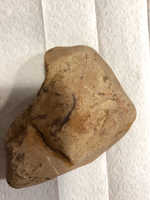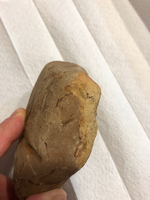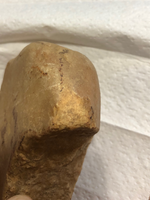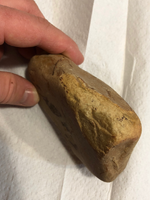Well, I have not read through this thread past my last comment, whenever that was. But, seeing it extend for several pages, I knew that there must be dissension, and likely argumentation, going on.
A few observations where crude artifacts are concerned, artifacts that often elicit "that's not an artifact" comments. I'm thinking of two such classes, and I find those two classes, in my own experience, in a particular field that I'll describe.
1. The more examples of crude artifacts you find, the easier to identify. But really that's the case with any class of artifact. There is always a learning curve. Two classes that come to mind, personally, would be notched weights, and hammerstones. If one is used to finding a great many hammerstones, you come to recognize them easily enough; if one has little experience with cruise, basic affair hammerstones, they are harder to recognize. Just that simple I believe, and that's probably what happened in this thread. There is always a learning curve, the reason newbies pick up "just rocks"; and because recognizing "just rocks" is second nature to experienced eyes, it's also the reason experienced folks often have trouble explaining to newbies why "it's just a rock".
2. About that field I mentioned. 25 years ago, the owner said "played out, but look if you want". Indeed, it was a farm going back to the 1600's, and I was to meet an old timer who had hunted it in the 1930's, when wonderful things were found.
A funny, and real good, thing happened. For about 6-8 years, the farmer plowed half way to China, and replenished that played out field. The wife and I found lots of nice points, a full grooved axe, a nice celt, etc. Over many years. It was no longer played out.
I found quite a number of chlorite and steatite pipe forms and pipe blanks. Never a finished pipe. Why? All those earlier generations had found all the killer examples, and the Mrs. and I were left to pick up pipe blanks that earlier hunters could simply pass on, if they had seen them.
Same with very rudimentary notched weights and hammerstones. Found lots. Was it because earlier generations just missed them? Well, maybe some of my better examples, yes. But, I'm thinking, in the case of the crudest, naw, they likely just left them in the dirt. These fields were just too good to collect "junk" artifacts. And that's why I'm the poor slob bringing home crude notched weights and hammerstones. And, because I find so many of each, I recognize them more readily then others might. Those earlier generations, hunting a killer field, could afford to leave low quality examples of things like hammerstones and notched weights. Me, and my generation, were the beggars who could not be choosers.
Believe me, for instance, I have notched weights that I would not post here, so rudimentary that I really don't need the aggravation of having folks not used to such artifacts telling me "that ain't an artifact", when I know full well, from experience, that it is.
And why have I found so many crude hammers and notched weights in that once great field(the farmer found a perfect pop eye birdstone in this field in the 30's, and gave it to that old timer, who was a young man in those days)? Because earlier generations could not be bothered; they could afford to collect only the very best examples.
Bottom line here. If you have tons of experience finding hammerstones, perhaps the least sexy of any artifact class, you'll develop an eye for them, and recognize them when you see them. That's how I felt about the OP's piece. Little or no experience, you might see "just a rock" that got whacked somehow....












